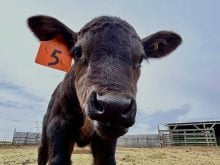Agricultural commodities, including livestock, have been quantified in various ways since the earliest farmers sold excess production. Weight has often been the primary measuring stick.
“It’s been the easiest way to measure, plus, we still sell cattle by the pound,” says Karin Schmid, Beef Production and Extension lead for Alberta Beef Producers. “The simplest answer to why we should continue to weigh is we can calculate average daily gain (ADG), cost of gain, and feed conversion. If we don’t know how heavy our calves are or how they’ve gained, we won’t know if we’re making any genetic or breeding program progress.”
Read Also

Harvest wraps up and fall work begins
At the Eppich famly ranch in western Saskatchewan, the fall harvest was successful with few breakdowns, cows and calves have been sorted and a new tractor has arrived
What weight tells us
Schmid says many reasons for weighing livestock jump to the forefront, with nutrition and health considerations leading the way.
While testing is still the best gauge of feed quality, animals eating well but not gaining could point to a nutritional deficiency. If illness is ruled out, an evaluation of feeding parameters might pinpoint a weakness requiring a change.
Schmid says the more likely culprit of condition loss is sickness.
“Often, the first sign of disease is an animal going off feed. When they’re not eating, they’re not gaining. And it’s important to measure this for verification. This could indicate parasites or other disease burdens not readily apparent.”
Knowing weights in the feedlot is also critical for the financial well-being of an operation, not only for ADG, cost of gain or feed conversion metrics, but to fall within a packer’s desired carcass limitations. With potential premiums and discounts in play, it’s crucial to market cattle at the right time.
“One aspect not as apparent when considering the importance of individual weights is drug dosages,” Schmid says. “Whether parasite controls, antimicrobials or antibiotics… all are based on weight. If we don’t have it, we could be overdosing and wasting expensive product, or underdosing and not getting the desired treatment effect.”
Weight in the cow herd
Schmid says weights are also valuable for commercial cow herds, helping to match them with their environment and available forage resources.
“Intake is highly correlated with weight, so it helps predict and match feed resources with animals. One of the best metrics is the weight of weaned calves per female exposed, because it combines both growth and reproductive efficiency. As weight increases, so does dry matter intake. It’s not necessarily a linear relationship but relates to optimizing a targeted mature cow size with their environment and feed resources.”
With limited resources, bigger cattle could be detrimental, whereas with abundant supplies, they will likely be efficient.
Schmid believes this balance of size, location, climate and growing conditions is too often overlooked or not seen as important to cow-calf producers.
“Cost of gain doesn’t only matter in the feedlot. It matters with growing calves on their mothers. We should call it ‘cost of maintenance’ and ask ourselves, ‘what is the cost of maintaining our cow herd at the right body condition and weight?’ And we won’t know the answer if we’re not able to scale them as adults.”
Reproductive focus and genetic optimization
Schmid says the body conditioning and weight of replacement heifer prospects relate directly to reproductive success and fertility rates. Fitting within an accepted target window of 50 to 60 per cent of mature size helps define maturity and this knowledge is useful in understanding the relationship between breeding cycles and nutrition.
“If they aren’t maturing when they should be in their first estrus window, it puts the whole breeding cycle behind. Additionally, if we’re seeing loss in those we’re trying to breed back on a declining plain of nutrition, breeding efforts, whether artificial insemination or natural, won’t be as successful.”
Schmid notes accessibility to weight information fosters growth and ensures operational goals have the best chance of being met. She acknowledges that expected progeny differences (EPDs), genomically enhanced EPDs and performance programs are vital to meeting these goals, but phenotypes are still required to increase accuracy and provide support.
“Pure genetic merit on its own only tells one part of the story. It doesn’t show how cattle are performing in a specific herd or environment. There’s a saying — ’In the age of genomic data, phenotypes are still king.’ We need data such as weight, to help underpin those genomic predictions. All parts need to work together to fine-tune production.”















